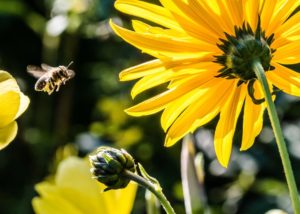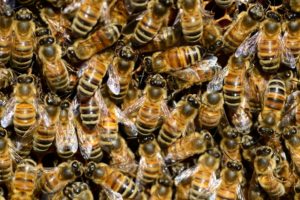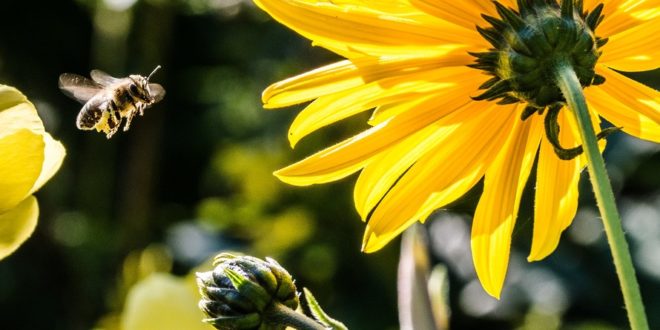Why Bees Are Important, and How to Run Your Own Backyard Beehive
They’re not so sweet when you’re suffering the wrath of a sting, but when it comes to environmental value bees are one of Mother Nature’s most important assets. In fact, bees are one of the hardest working creatures on the planet, and have earned their ‘busy’ reputation for a reason.
 Not only do they make a mean pot of honey, but they’re responsible for pollinating over 16% of the world’s flowering plant species, and around 400 different types of agricultural crops. This pollination service makes them multi-billion dollar assets, as well as the sole proprietors of produce like cucumbers, blueberries, almonds, apples, cranberries and cherries.
Not only do they make a mean pot of honey, but they’re responsible for pollinating over 16% of the world’s flowering plant species, and around 400 different types of agricultural crops. This pollination service makes them multi-billion dollar assets, as well as the sole proprietors of produce like cucumbers, blueberries, almonds, apples, cranberries and cherries.
On a global scale, the superfamily Apoidea is made up of more than 5700 species of bees, with New Zealand housing 28 native species and 13 introduced. Discounting wild swarms, these bees keep more than 300,000 commercial hives in business, which produce around 9000 tonnes of honey a year.
Beekeeping beyond business
Beekeeping first arrived in New Zealand in the 1850s, and originally existed as a home craft. It quickly turned commercial, and now New Zealand is famous for producing some of the sweetest honey on the planet. Not to mention our coveted Mānuka variety, a mono-floral honey that’s renowned for its antibacterial properties and alternative medicine credentials.
 But that’s not to say that farmer’s markets and speciality supermarkets are your only source of premium honey. If you’ve got a love for honey that goes beyond a luxuriant drizzle on your morning muesli, why not consider setting up your own DIY beehive and joining the latest urban craze? Like veggie patches, BBQs, hot tubs and puppies, beehives are quickly becoming a Kiwi backyard essential.
But that’s not to say that farmer’s markets and speciality supermarkets are your only source of premium honey. If you’ve got a love for honey that goes beyond a luxuriant drizzle on your morning muesli, why not consider setting up your own DIY beehive and joining the latest urban craze? Like veggie patches, BBQs, hot tubs and puppies, beehives are quickly becoming a Kiwi backyard essential.
Not only does a home hive make for fantastic dinner party conversation, but you’ll also unlock access to your own personal stash of organic honey, and be helping to nurture the planet in the process.
DIY hives and honey
So how can you pull it off? Read on for our DIY guide to setting up your own beehive, and becoming a keeper that packs a buzz.
- The first step is to invest in a good book on beekeeping. You’d be surprised at how popular it’s become over the past few years, which means getting your hands on a beginner’s guide is easy. We love Kim Flottum’s ‘The Backyard Beekeeper’ and C.P. Dadant’s ‘First Lessons in Beekeeping.’ If you’re really enthusiastic, you can even subscribe to niche magazines like Bee Culture.
- Next up is joining your local Beekeeping Association. Membership is a wonderful way to source local information, as well as network with fellow beekeepers. They can also be a huge help when it comes to ordering bees and equipment.
- Before you set your heart on a backyard beehive be sure to check your local city codes. There might be a limit on the number of hives that are allowed in your area, or regulations on how close hives can be to your neighbours.
 Bees get busy in the springtime, which means September, October and November are the best times to get your hive buzzing. The warm weather makes it easier for bees to build a strong hive, so be patient and don’t rush the process if it’s the wrong month.
Bees get busy in the springtime, which means September, October and November are the best times to get your hive buzzing. The warm weather makes it easier for bees to build a strong hive, so be patient and don’t rush the process if it’s the wrong month.
- When choosing a location for your hive, don’t forget to take the bigger picture into account. You’ll need at least 15 feet or so of space around the hive, as well as a relatively uninterrupted flight path for bees to buzz back and forth.
- Beekeeping isn’t a hugely expensive hobby, but there are a few things you’ll need to invest in. you’ll need the all-important beekeeping suit, complete with a hood, mask and gloves. Beehives are purchased individually, and you’ll also need a smoker, a hive tool and an extractor if you plan on harvesting honey.
- Buying your bees is one of the most exciting steps, with most new keepers choosing to place an order as opposed to going out and catching their own swarm. A queen and a legion of worker bees is called a ‘nuc,’ strange as it sounds.
- Local conditions play a huge role in the health of your bees, so don’t scrimp on research. There’s climate, seasons and environmental conditions to take into account, which means the needs of your hive will vary depending on where you live. For example, if spring arrives a little later than usual you might need to feed your bees until flowers begin to open up and nectar starts flowing.
- Ahhh the honey harvest. Nothing’s quite as rewarding as gathering your own golden streams of raw organic honey, so savour the moment it comes flowing out the hive. The easiest way to get your hands on this syrupy sweet by-product is to scoop it straight out of the honeycomb, however with the help of an extractor you can separate the honey from the wax and create a premium product.
Whether you become a connoisseur of home-farmed honey, churn out your very own Bert’s Bees inspired lip balm or simply enjoy the art of beekeeping as a hobby in itself, this guide should get you well on your way to becoming a backyard keeper.










Join the Discussion
Type out your comment here:
You must be logged in to post a comment.